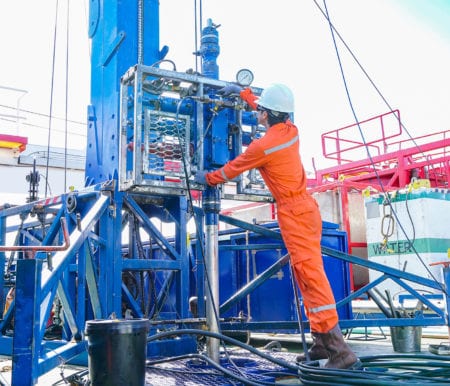Editor’s Note: This is the third part of a series about a bit of Phil Schwarz’s personal experience as a wireline field engineer in Alaska. You can read part one here and part two here.
The job of an oilfield field service engineer is a dangerous one. Any field job in the oil & gas industry is inherently dangerous for that matter. As a former onshore and offshore wireline field engineer, hazardous activities were just part of the daily job. Here’s a look at just some of those hazards.

- Radioactive nuclear sources were handled and placed in electronic devices that were lowered down the well to identify rock properties and hydrocarbons.
- Shaped charge explosives that are lowered down the well inside perforating guns. These explosives generate millions of psi (pounds per square inch) in pressure to perforate (create holes in) the steel well casing, cement behind the casing, and then about 6 to 8 feet into the formation to allow the oil and gas to flow from the rock formation into the well.
- Working with equipment under tens of thousands of psi pressure was another hazard. It was common where the pressure became ‘trapped’ in equipment and certain steps were required to relieve the pressure so that no one was injured from flying debris during the process.
- Even with all the hazards above, driving was considered the most hazardous risk. It was common that a wireline job would take 48 hours to complete. As a Field Engineer you’re awake for all of this time, which wasn’t a challenge given the hazards of the operation, the revenues and costs at stake. The longest period of time I stayed awake for a job was 76 hours (over 3 days!). As you can imagine, the hazards associated with the drive home (typically 2 hours) occur when all the adrenaline has subsided. Every year there would be instances when Field Engineers fall asleep at the wheel on the way home.
The processes in place to manage these risks were manual in nature back then. Talking with former colleagues, there unfortunately hasn’t been much improvement in the past 20 years.
- Radioactive nuclear sources were checked in and checked out of their nuclear pits on hard copy forms. Field Engineers had to record when a radioactive source was removed from the pit and returned.
- Radioactive sources had to be routinely ‘wipe tested’ that there were no radioactive leaks. The ‘wipe tests’ were documented in an outdated application that was internally designed and maintained and costs millions of dollars to support that no Field Engineer liked using.
- Inventory of explosives was all tracked on hard copy forms. Field Engineers and shop foreman had to record when explosives were removed from inventory and returned.
- Hazardous material (HAZMAT) forms were required for any shipment of radioactive sources or explosives to the wellsite or any other location.
- Pressure containing equipment had to be routinely pressure tested and recorded. The system was antiquated and not designed for offline use.
- Driving trips required the completion of pre-trip driving forms identifying the driving route.
- Any risks identified with any one of these hazards or others was documented on a manual Risk Identification Form.
Using a modern, mobile, field service management platform, Predix ServiceMax helps companies maximize business outcomes associated with servicing equipment. All of these processes can easily be digitally transformed so that the associated risks are reduced and safety and compliance incidents are lowered. In fact, a recent survey showed that on average, our customers received a decrease of 13 percent in compliance incidents. Forms, inventory records, wipe test records, and checklists are all electronically captured using a device we use every day…our phone. Designed specifically for an inherently offline job, all of these processes can be done using a modern application designed when there is no connectivity. When connected using a cellular or Wi-Fi connection, these records would automatically be updated to the cloud-based application. If I only had ServiceMax back then!
ServiceMax from GE Digital has a booth in the Baker Hughes exhibit at the Offshore Technology Conference being held in Houston April 30 – May 3, 2018. We’ll also have a theater presentation at 3pm on Wednesday, May 2. Come on by and say hello and learn how to start your service transformation!


Phil,
Thank you for the insight… this is very interesting stuff. What strikes me is that it’s so hard to believe these processes haven’t been updated, especially in light of the threat of terrorism. I would think there would be more automated processes to track these hazardous materials. Thanks again for taking the time go give us more insight on your experiences.
Thanks for your response, Tom! We share the same surprise! I’ve reached out to former colleagues in the OFS market and in some cases they’ve gone backwards! .xls and hard copy forms continue to be the norm. Regulatory requirements include the steps to ensure tracking, control, and management of hazardous materials. Regulatory requirements do not dictate the technologies (automation vs. manual) to be used to do this.